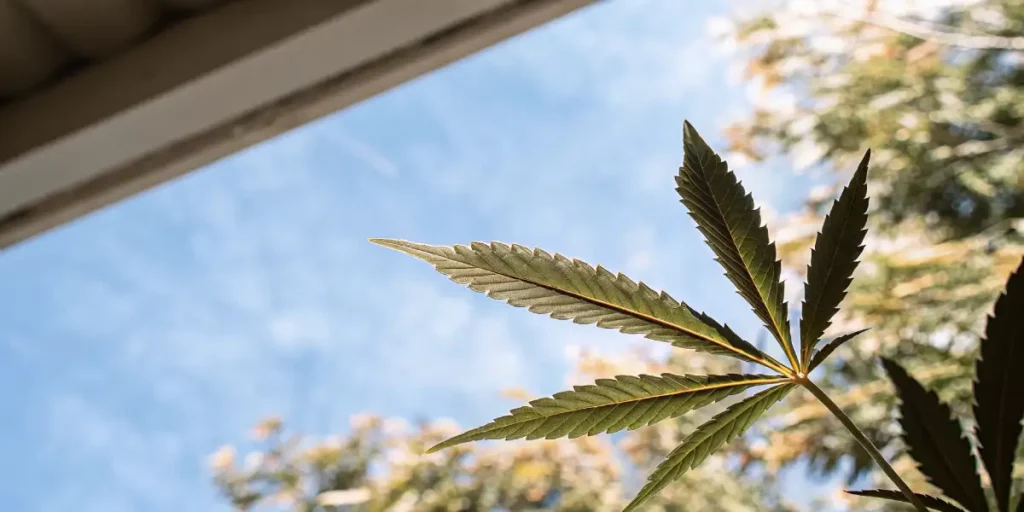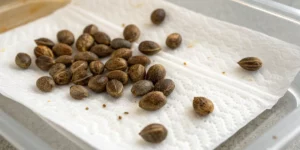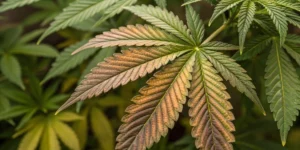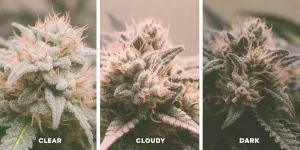Growing cannabis can be a rewarding hobby, but it comes with its challenges. One of the most common issues faced by growers is cannabis leaf problems. Whether you’re a novice or a seasoned cultivator, keeping your plants healthy means knowing what those leaves are telling you.
Cannabis leaves are like the plant’s report card. They can indicate various issues, from nutrient deficiencies to pest infestations. Rectifying cannabis leaf problems early can save your harvest and improve yields. Let’s dive into the common signs you might encounter.
One frequent issue is cannabis leaf yellowing. Often, this is a sign of nutrient deficiencies. But it can also mean overwatering or poor drainage. Knowing the exact cannabis leaf yellowing causes can help you tailor your treatment plan effectively—especially when growing sensitive, high-yielding strains like Blue Dream, which thrive best with proper nutrient and moisture balance.
Identifying Cannabis Leaf Problems
Spotting the signs of trouble early is crucial. Keep an eye out for brown spots on cannabis leaves. These spots can indicate several issues, including fungal infections or nutrient imbalances. It’s essential to diagnose accurately to treat effectively.
Another common symptom is leaf curling. Cannabis leaf curling treatment usually involves adjusting environmental factors like humidity and temperature. Sometimes, curling can be due to pests. Regularly inspecting your plants can help catch these issues early.
Besides to visual inspections, using tools like pH meters and moisture sensors can provide insights into the root causes of plant stress. These tools help determine if nutrient lockout or overwatering is contributing to symptoms like yellowing or curling.
Engaging with online communities and forums can also be beneficial. Many growers share their experiences and solutions to common issues. This collective knowledge can provide new strategies for tackling problems in your grow operation.
Nutrient Deficiencies
Nutrient deficiencies in cannabis are a frequent cause of leaf problems. For instance, nitrogen deficiency can cause yellowing and stunted growth. On the other hand, a phosphorus shortage might result in dark, discolored leaves.
Calcium and magnesium are also crucial. A lack of these can lead to weak stems and brown spots on cannabis leaves. Consider adding supplements to your feeding regimen to address these deficiencies.
Recognizing the specific symptoms associated with each deficiency is essential. For example, cannabis leaf yellowing causes linked to magnesium deficiency often show as yellowing between the leaf veins. Tailoring your response based on symptoms ensures a more effective treatment.
Monitoring the pH of your growing medium is also vital, as improper pH levels can lead to nutrient lockout, exacerbating cannabis leaf nutrient deficiencies. Ensuring your pH is within the optimal range allows for the best nutrient uptake.
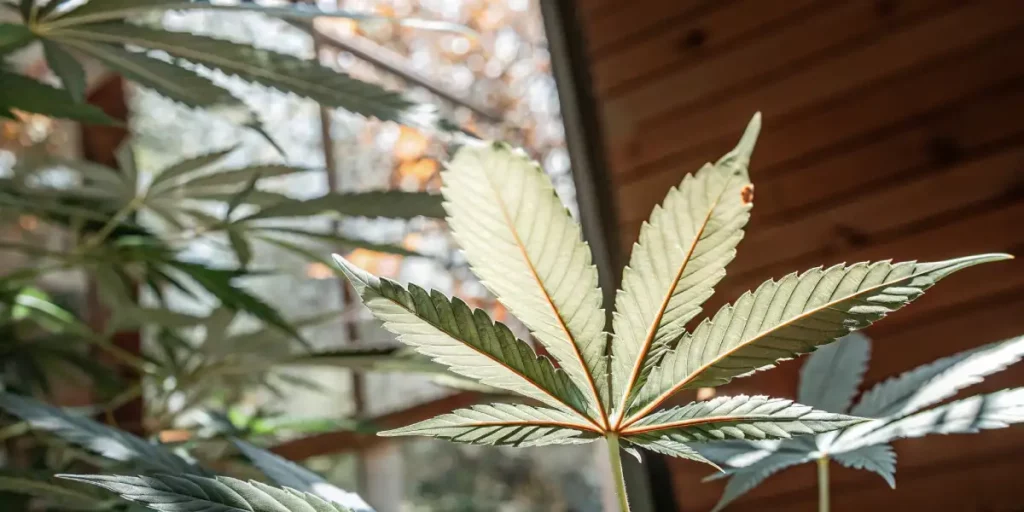
Pest Control
Pests are another major cause of cannabis leaf problems. Common invaders include spider mites, aphids, and whiteflies. These pests can cause significant damage, leading to curled, discolored leaves.
Implementing a good cannabis leaf pest control strategy is vital. Regular inspections and the use of natural predators can keep pest populations in check. Using neem oil as a preventative measure can also be effective.
Beyond regular inspections, employing integrated pest management (IPM) strategies can be an effective approach. IPM combines biological, cultural, and chemical methods to manage pest levels and maintain overall plant health.
Rotating different pest control methods can prevent pests from developing resistance. This approach, combined with consistent cannabis leaf pest control practices, helps maintain a healthy growing environment with minimal infestations.
Environmental Stress Factors
Environmental stressors can also lead to cannabis leaf problems. High temperatures can cause leaves to curl, while low temperatures might result in slow growth. Maintaining an optimal temperature range is crucial.
Humidity levels are another critical factor. High humidity can lead to mold, while low humidity might cause leaves to dry out and curl. Investing in a good hygrometer can help you keep track of these parameters.
Lighting conditions are equally important. Inadequate light can weaken plant growth, while excessive light may cause leaf burn and other stress symptoms. Adjusting light intensity and duration can help mitigate these issues.
Ensuring that plants are not exposed to drafts or sudden temperature changes is also crucial. Such fluctuations can stress plants, leading to symptoms like cannabis leaf yellowing and curling. Consistent conditions are key to preventing stress-related problems.
Common Cannabis Leaf Problems and Solutions
Knowing the root cause of cannabis leaf problems is the first step towards finding a solution. With the right approach, most issues can be resolved without drastic measures.
For yellowing leaves, check your watering schedule and nutrient levels. Adjusting these can often reverse the problem. For brown spots, consider both nutrient imbalances and potential pest issues.
Regularly updating your knowledge about plant care techniques can provide new insights into resolving issues during cultivation. Staying informed about the latest research and best practices can enhance your ability to maintain healthy plants.
Consulting with professional growers or agricultural extension services can offer additional guidance. These experts can provide tailored advice for handling specific challenges, ensuring you achieve optimal results.
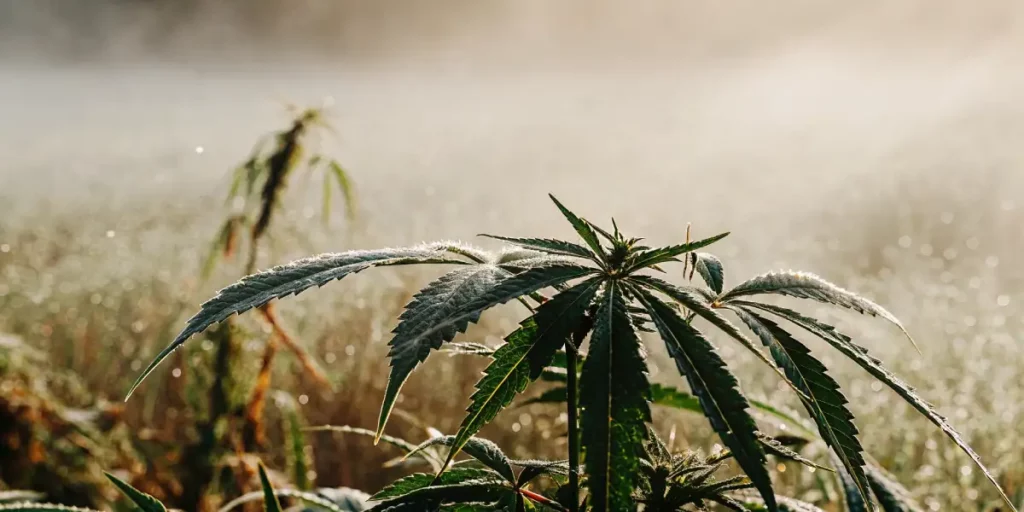
FAQs of cannabis leaf problems
What causes cannabis leaves to turn yellow?
Cannabis leaf yellowing causes can vary. The most common reason is a lack of nitrogen, a crucial nutrient for growth. When nitrogen is insufficient, older leaves tend to yellow and die off as the plant redirects nutrients to newer foliage.
Another cause could be overwatering. Excess water can drown the roots, preventing them from absorbing necessary nutrients. Ensure your pots have proper drainage and consider watering less frequently if you suspect this is the issue.
Improper pH levels can also contribute to yellowing. If the pH is too high or too low, nutrient uptake can be hindered, leading to yellowing. Regularly testing and adjusting your pH can help prevent these cannabis leaf problems.
Additionally, environmental factors like temperature and humidity can exacerbate yellowing. Ensuring a stable growing environment can help mitigate cannabis leaf yellowing causes and promote healthier growth.
How do I treat curling cannabis leaves?
Cannabis leaf curling treatment starts with identifying the cause. If the curling is due to environmental stress, adjust the temperature and humidity. Ensure your grow area is well-ventilated to prevent heat stress.
If pests are the cause, such as spider mites, consider introducing natural predators like ladybugs. Alternatively, use a mild insecticidal soap to treat the affected plants, ensuring thorough coverage.
Overwatering can also lead to curling. Ensuring proper drainage and adjusting your watering schedule can help alleviate this issue. Monitoring soil moisture levels can prevent further cannabis leaf problems.
Checking for nutrient imbalances is also crucial. Deficiencies or toxicities can cause leaves to curl, so ensure your plants receive the right nutrient balance to avoid cannabis leaf nutrient deficiencies.
What should I do about brown spots on cannabis leaves?
Brown spots on cannabis leaves often point to nutrient deficiencies or pest problems. First, check your nutrient solution. Ensure your plants receive a balanced mix with sufficient calcium and magnesium.
If your nutrients are balanced, inspect for pests. Check the underside of leaves for signs of infestation. Treat promptly with neem oil or insecticidal soap to prevent further damage.
Fungal infections can also cause brown spots. Maintaining good airflow and reducing humidity can help prevent fungal growth, thereby minimizing cannabis leaf problems related to fungal infections.
Conducting soil tests can reveal any underlying issues with nutrient availability. Addressing these findings can prevent and correct brown spots on cannabis leaves, promoting overall plant health.
How can I prevent cannabis leaf nutrient deficiencies?
Prevention is better than cure when it comes to cannabis leaf nutrient deficiencies. Start with a quality soil mix that contains essential nutrients. Regularly test your soil or growing medium’s pH levels to ensure nutrients are available.
Use a comprehensive feeding schedule tailored to your plant’s growth stage. Products designed specifically for cannabis, like those used for strains such as Blue Dream, can help maintain nutrient balance.
Implementing a rotation of different fertilizers can prevent nutrient build-up and lockout, thus reducing cannabis leaf problems. Alternating between organic and synthetic fertilizers can provide a broader range of nutrients.
Monitoring plant growth stages and adjusting nutrient levels accordingly can prevent deficiencies. Being proactive in managing your feeding schedule can ensure healthy, vibrant cannabis plants free from deficiencies.
What are effective cannabis leaf pest control methods?
Effective cannabis leaf pest control involves both prevention and treatment. Begin by maintaining a clean growing environment. Remove any dead plant material and ensure good airflow around your plants.
For treatment, natural options like neem oil and insecticidal soaps can deter and eliminate pests. Introducing beneficial insects like ladybugs or predatory mites can also keep pest populations under control.
Using companion planting techniques can be a natural way to deter pests. Certain plants can repel pests, reducing the likelihood of cannabis leaf problems related to infestations.
Regularly rotating crops and cleaning growing areas between cycles can prevent pest build-up. This practice, combined with diligent cannabis leaf pest control, ensures a healthy crop with minimal pest issues.

